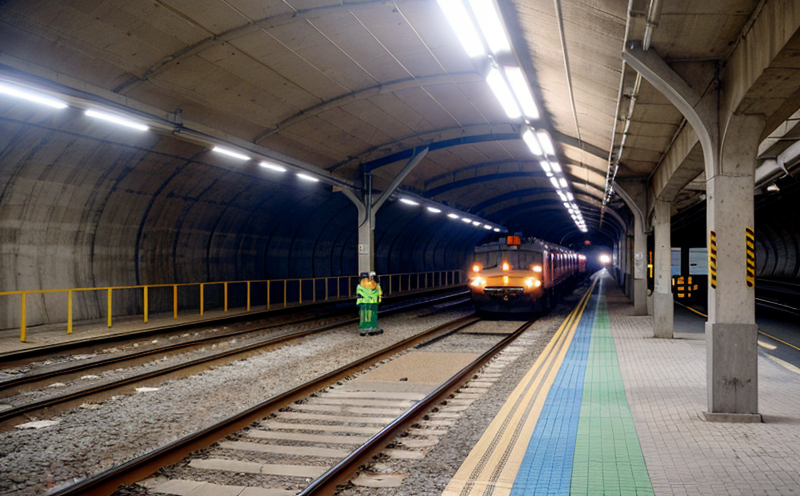EN 50317 Overhead Line Current Collection Testing on Bridges
The EN 50317 standard is pivotal in ensuring the safety and reliability of overhead line current collection systems used in railway infrastructure. This test evaluates how effectively the contact between pantographs and overhead lines operates under various bridge conditions, which is critical for uninterrupted and safe train operations.
The testing process involves simulating real-world scenarios where a pantograph interacts with an overhead line on bridges characterized by specific geometries and materials. The objective is to assess the current collection performance while considering factors such as ambient temperature, humidity, wind speed, and contact pressure.
During this test, engineers use specialized equipment to replicate field conditions that can impact current flow. This includes variable load settings and environmental simulations to ensure the pantograph maintains optimal contact with the overhead line throughout its journey across different sections of a bridge.
The importance of this testing cannot be overstated, especially for bridges designed with unique geometries or materials that could affect current collection performance. For instance, bridges built using concrete or steel structures may present varying challenges compared to those made from other materials like wood or composite structures.
Understanding these differences is crucial because they can influence the electrical characteristics of the contact system. Factors such as surface roughness, material conductivity, and thermal expansion coefficients play significant roles in determining the efficiency of current flow between the pantograph and overhead line.
The test setup typically includes a moving platform equipped with a pantograph capable of replicating the motion seen during train operation. This platform is designed to traverse different sections of a mock bridge structure that mimics real-world conditions. By doing so, engineers can observe how changes in geometry or material composition impact current collection.
Once the test setup has been configured according to specific parameters outlined in EN 50317, data acquisition systems are implemented to monitor various performance metrics. These include voltage levels, current intensity, and contact forces measured at different points along the bridge. Additionally, thermal imaging cameras are used to detect any heat signatures indicative of poor contact areas.
The collected data is then analyzed using sophisticated software tools that compare actual measurements against predefined acceptance criteria specified in EN 50317. If discrepancies arise between expected outcomes and observed results, adjustments may be necessary until all parameters meet the required standards.
Compliance with this standard ensures not only the safety of passengers but also minimizes disruptions to service schedules caused by equipment failures or malfunctions. By adhering strictly to EN 50317 guidelines during testing procedures, railway operators can maintain high levels of reliability and availability for their overhead line current collection systems.
In summary, implementing rigorous tests like those defined in EN 50317 is essential for ensuring the integrity and performance of overhead line current collection systems on bridges. Through meticulous evaluation processes involving realistic simulations and advanced analytical techniques, these tests provide valuable insights into potential issues that might otherwise go unnoticed until they become operational problems.
Why Choose This Test
- Ensures reliability and safety of overhead line current collection systems on bridges.
- Helps identify potential issues early in the development process, reducing maintenance costs later.
- Aids in compliance with international standards and regulatory requirements.
- Promotes consistency across different bridge structures by standardizing testing procedures.
- Supports continuous improvement through regular retesting of existing systems.
Quality and Reliability Assurance
Implementing EN 50317 overhead line current collection testing on bridges is a cornerstone in maintaining the highest standards of quality and reliability for railway infrastructure. By adhering to this standard, operators can ensure that their systems function optimally under all anticipated conditions.
The rigorous nature of these tests helps prevent failures that could lead to disruptions in service schedules or safety hazards. Regular testing allows for proactive identification of weak points within the system, enabling timely interventions before they escalate into larger problems. This approach not only enhances overall operational efficiency but also contributes significantly towards achieving long-term sustainability goals.
Moreover, compliance with EN 50317 fosters trust among stakeholders by demonstrating a commitment to excellence in design and execution. It sets a benchmark for best practices that can be emulated across similar projects worldwide. In addition to enhancing credibility, adherence to this standard also promotes collaboration between different entities involved in railway maintenance and construction.
Ultimately, the implementation of EN 50317 overhead line current collection testing on bridges underscores the importance of continuous improvement and innovation within the industry. By embracing these principles, operators can pave the way for safer, more efficient rail networks capable of meeting future challenges head-on.
International Acceptance and Recognition
The acceptance and recognition of EN 50317 standards extend beyond national borders, making it a widely adopted framework globally. Many countries have incorporated these guidelines into their own regulations to ensure consistent quality across different regions.
Affirmative compliance with this standard is essential for international projects involving multiple jurisdictions. It provides a common ground where all parties involved can reference the same set of criteria when evaluating system performance or conducting audits. This uniformity streamlines collaboration efforts and reduces misunderstandings related to varying national standards.
Furthermore, adherence to EN 50317 enhances the reputation of companies engaged in railway infrastructure projects abroad. Demonstrating proficiency with internationally recognized benchmarks instills confidence among clients seeking reliable partners for large-scale undertakings. Such partnerships often lead to increased business opportunities both domestically and internationally.
In conclusion, embracing EN 50317 standards not only guarantees world-class performance but also opens doors to broader market access. As the railway industry continues to grow globally, maintaining high standards through rigorous testing procedures remains crucial for sustained success in this competitive landscape.





